Effective Human Resources and Organizational Behavior
VerifiedAdded on 2023/06/15
|21
|1198
|314
AI Summary
This presentation covers the importance of managing human resources, recruitment and retention, fair treatment and legal compliance, training and development, effective organizational design, and promoting and sustaining a positive culture. It provides strategies to implement these practices and embrace organizational change.
Contribute Materials
Your contribution can guide someone’s learning journey. Share your
documents today.

Critique Critique Effective Human
Resources and Organizational Behavior
Name of the Student
Name of the University
Author Note
Resources and Organizational Behavior
Name of the Student
Name of the University
Author Note
Secure Best Marks with AI Grader
Need help grading? Try our AI Grader for instant feedback on your assignments.
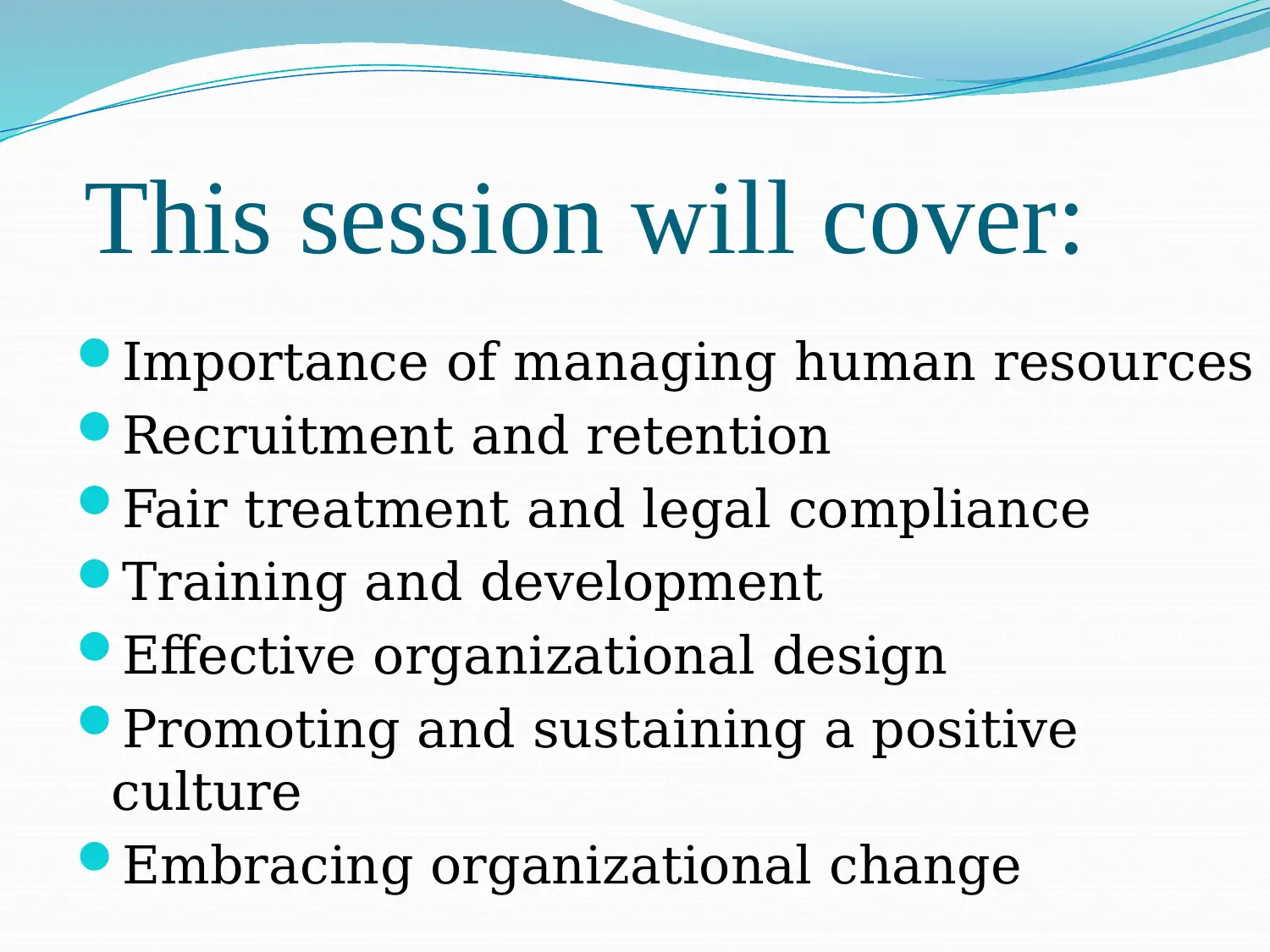
This session will cover:
Importance of managing human resources
Recruitment and retention
Fair treatment and legal compliance
Training and development
Effective organizational design
Promoting and sustaining a positive
culture
Embracing organizational change
Importance of managing human resources
Recruitment and retention
Fair treatment and legal compliance
Training and development
Effective organizational design
Promoting and sustaining a positive
culture
Embracing organizational change
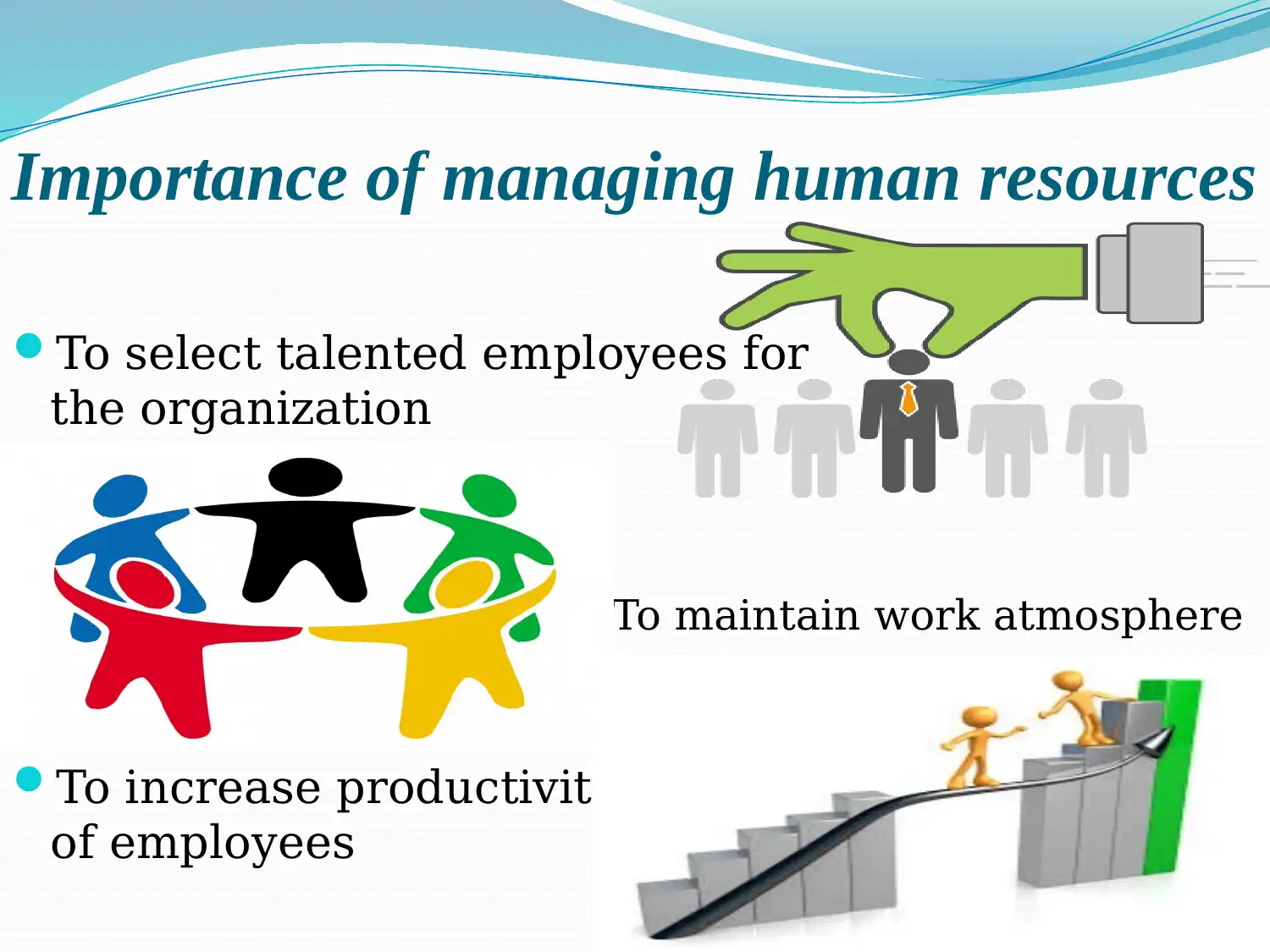
Importance of managing human resources
To select talented employees for
the organization
To maintain work atmosphere
To increase productivity
of employees
To select talented employees for
the organization
To maintain work atmosphere
To increase productivity
of employees
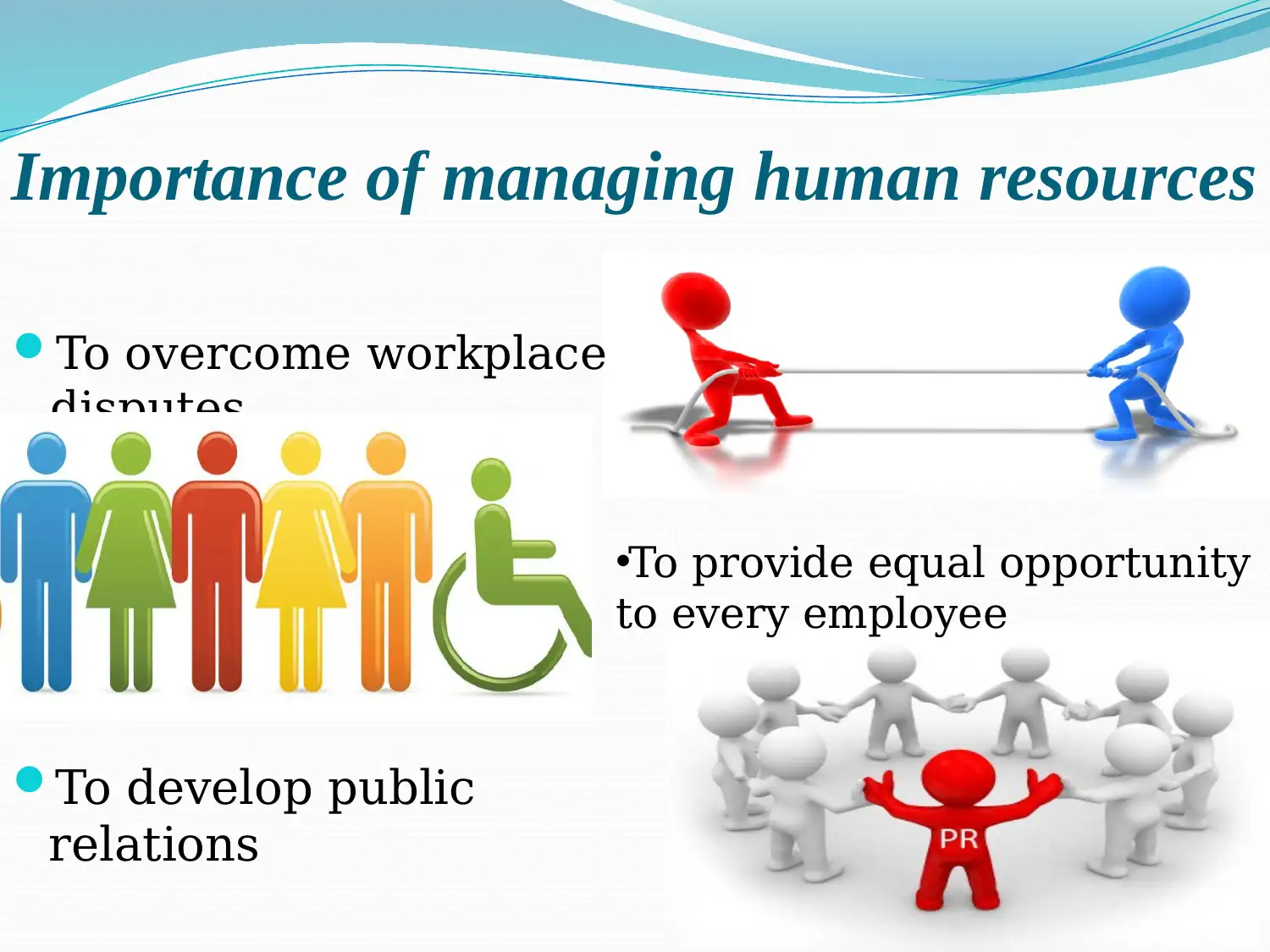
Importance of managing human resources
To develop public
relations
To overcome workplace
disputes
•To provide equal opportunity
to every employee
To develop public
relations
To overcome workplace
disputes
•To provide equal opportunity
to every employee
Secure Best Marks with AI Grader
Need help grading? Try our AI Grader for instant feedback on your assignments.
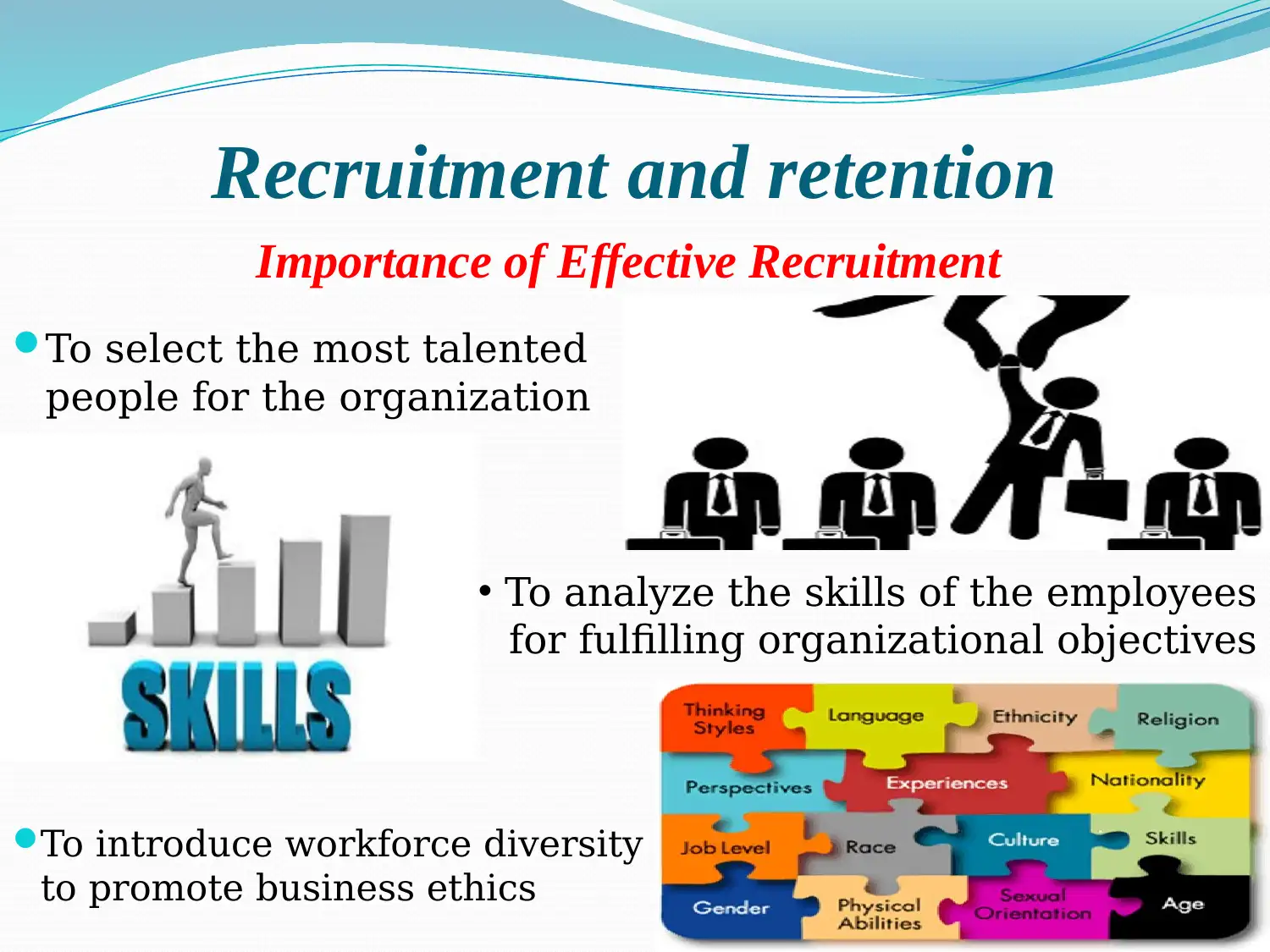
Recruitment and retention
To introduce workforce diversity
to promote business ethics
To select the most talented
people for the organization
• To analyze the skills of the employees
for fulfilling organizational objectives
Importance of Effective Recruitment
To introduce workforce diversity
to promote business ethics
To select the most talented
people for the organization
• To analyze the skills of the employees
for fulfilling organizational objectives
Importance of Effective Recruitment
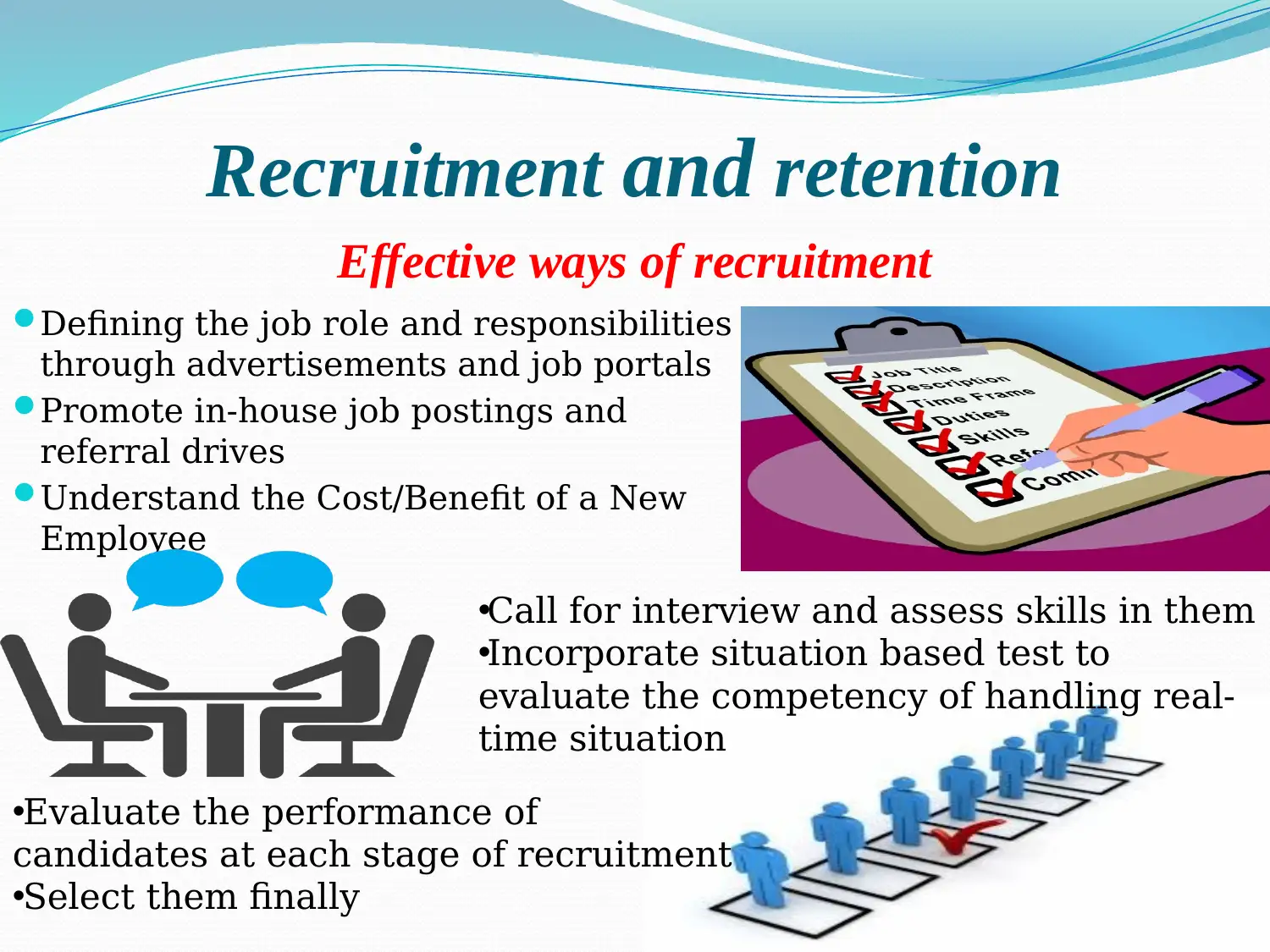
Recruitment and retention
•Evaluate the performance of
candidates at each stage of recruitment
•Select them finally
Defining the job role and responsibilities
through advertisements and job portals
Promote in-house job postings and
referral drives
Understand the Cost/Benefit of a New
Employee
•Call for interview and assess skills in them
•Incorporate situation based test to
evaluate the competency of handling real-
time situation
Effective ways of recruitment
•Evaluate the performance of
candidates at each stage of recruitment
•Select them finally
Defining the job role and responsibilities
through advertisements and job portals
Promote in-house job postings and
referral drives
Understand the Cost/Benefit of a New
Employee
•Call for interview and assess skills in them
•Incorporate situation based test to
evaluate the competency of handling real-
time situation
Effective ways of recruitment
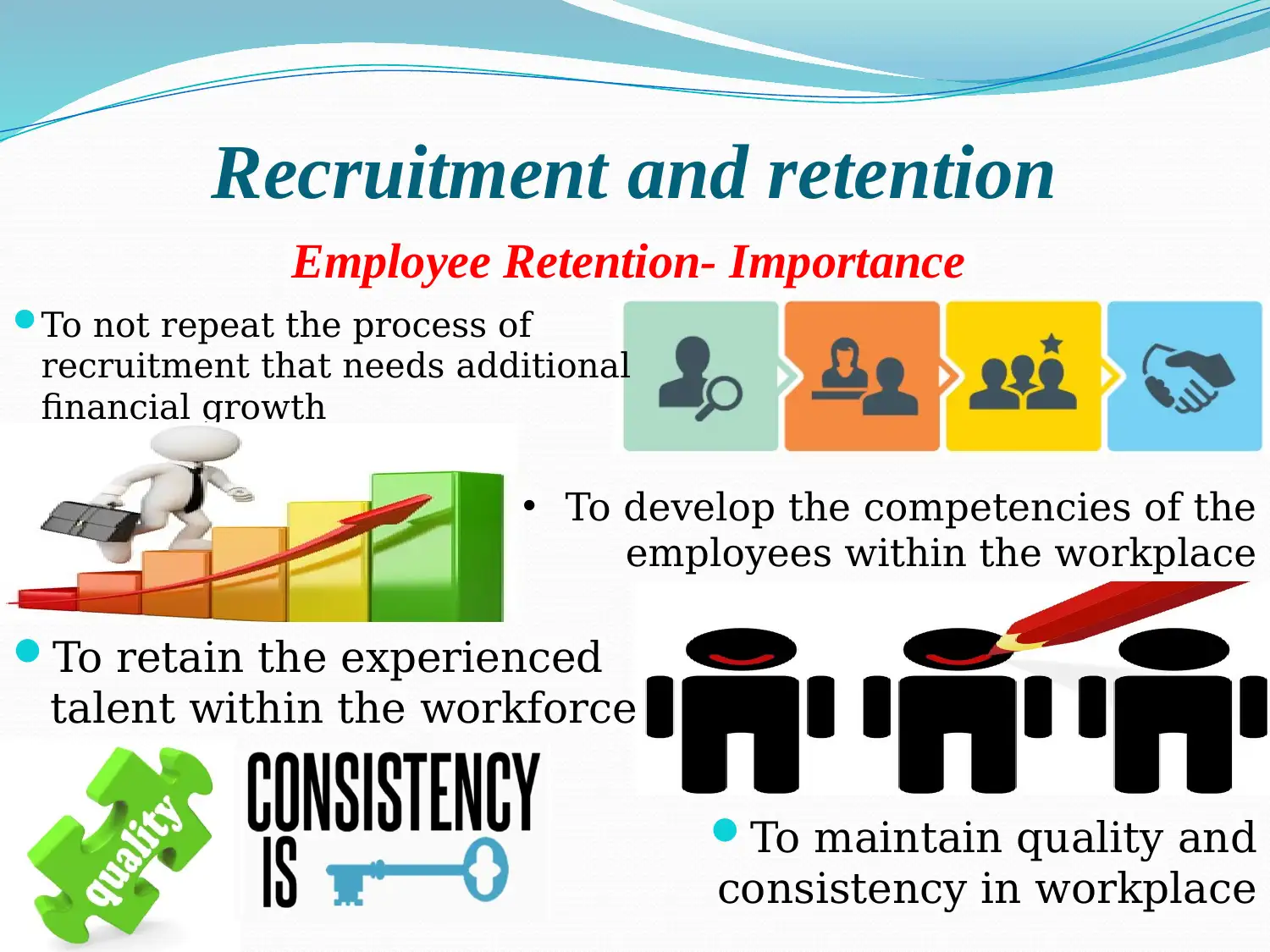
Recruitment and retention
To maintain quality and
consistency in workplace
• To develop the competencies of the
employees within the workplace
Employee Retention- Importance
To retain the experienced
talent within the workforce
To not repeat the process of
recruitment that needs additional
financial growth
To maintain quality and
consistency in workplace
• To develop the competencies of the
employees within the workplace
Employee Retention- Importance
To retain the experienced
talent within the workforce
To not repeat the process of
recruitment that needs additional
financial growth
Paraphrase This Document
Need a fresh take? Get an instant paraphrase of this document with our AI Paraphraser
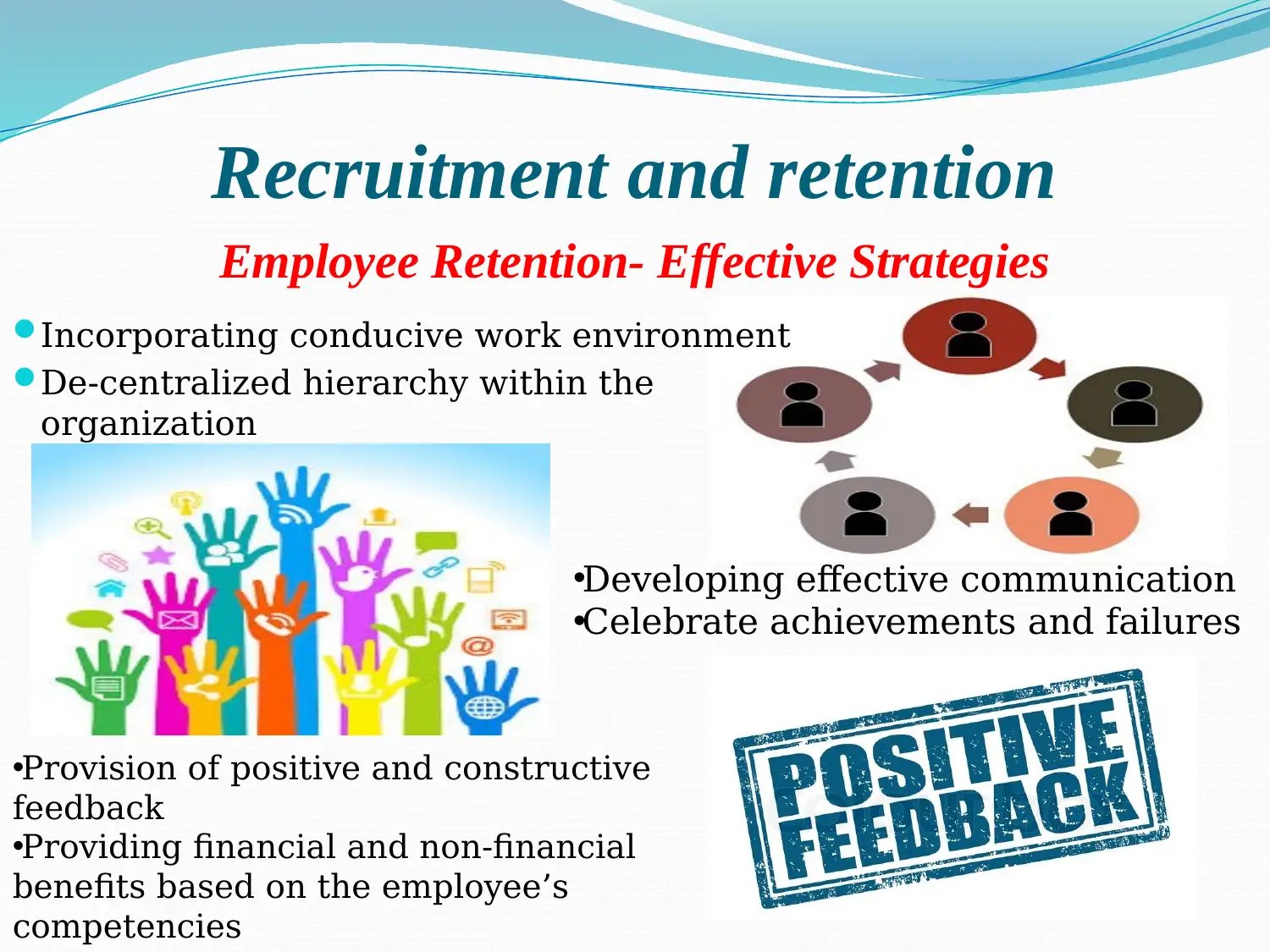
Recruitment and retention
•Developing effective communication
•Celebrate achievements and failures
Employee Retention- Effective Strategies
•Provision of positive and constructive
feedback
•Providing financial and non-financial
benefits based on the employee’s
competencies
Incorporating conducive work environment
De-centralized hierarchy within the
organization
•Developing effective communication
•Celebrate achievements and failures
Employee Retention- Effective Strategies
•Provision of positive and constructive
feedback
•Providing financial and non-financial
benefits based on the employee’s
competencies
Incorporating conducive work environment
De-centralized hierarchy within the
organization
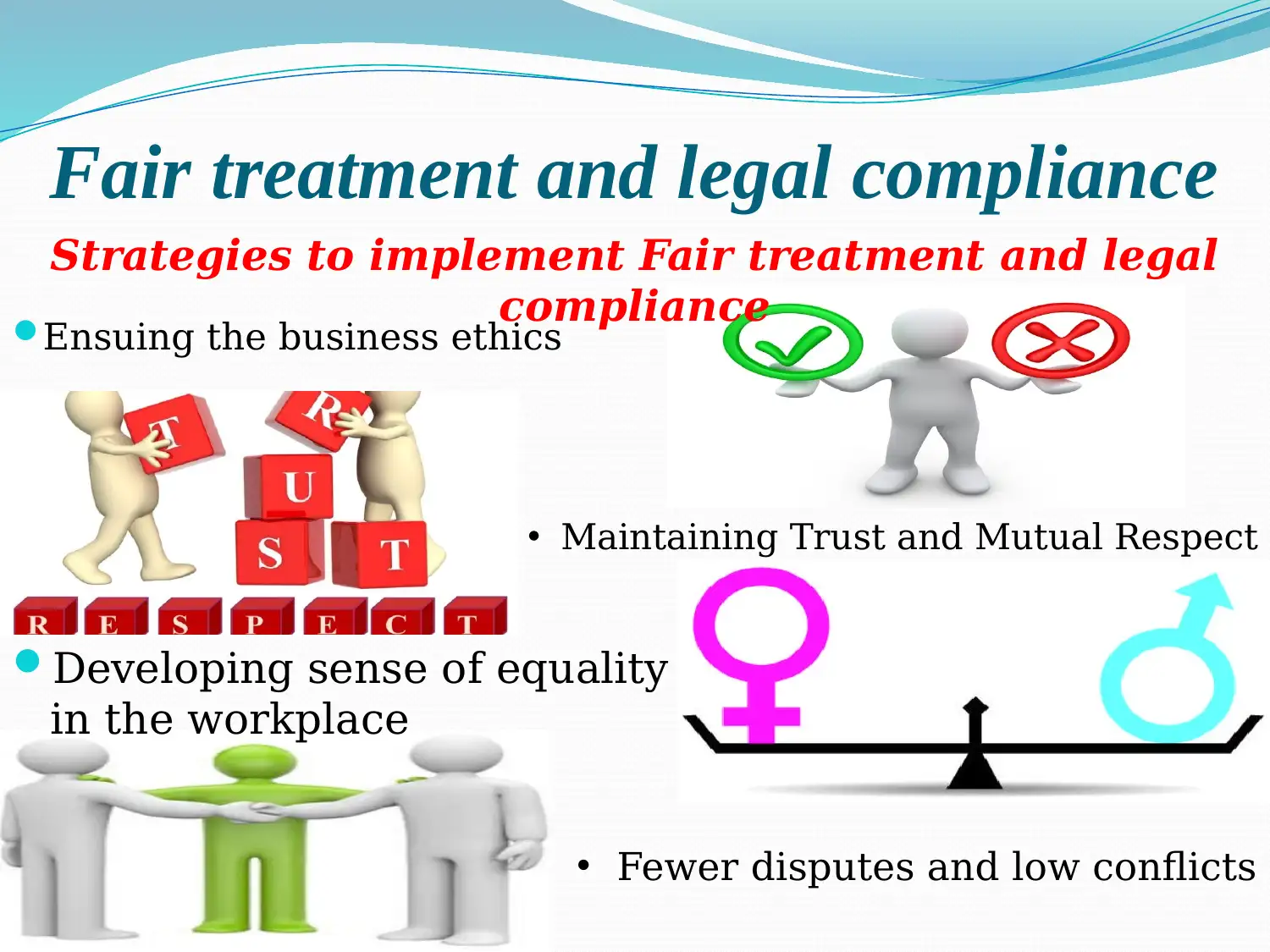
Fair treatment and legal compliance
Developing sense of equality
in the workplace
Ensuing the business ethics
• Maintaining Trust and Mutual Respect
Strategies to implement Fair treatment and legal
compliance
• Fewer disputes and low conflicts
Developing sense of equality
in the workplace
Ensuing the business ethics
• Maintaining Trust and Mutual Respect
Strategies to implement Fair treatment and legal
compliance
• Fewer disputes and low conflicts
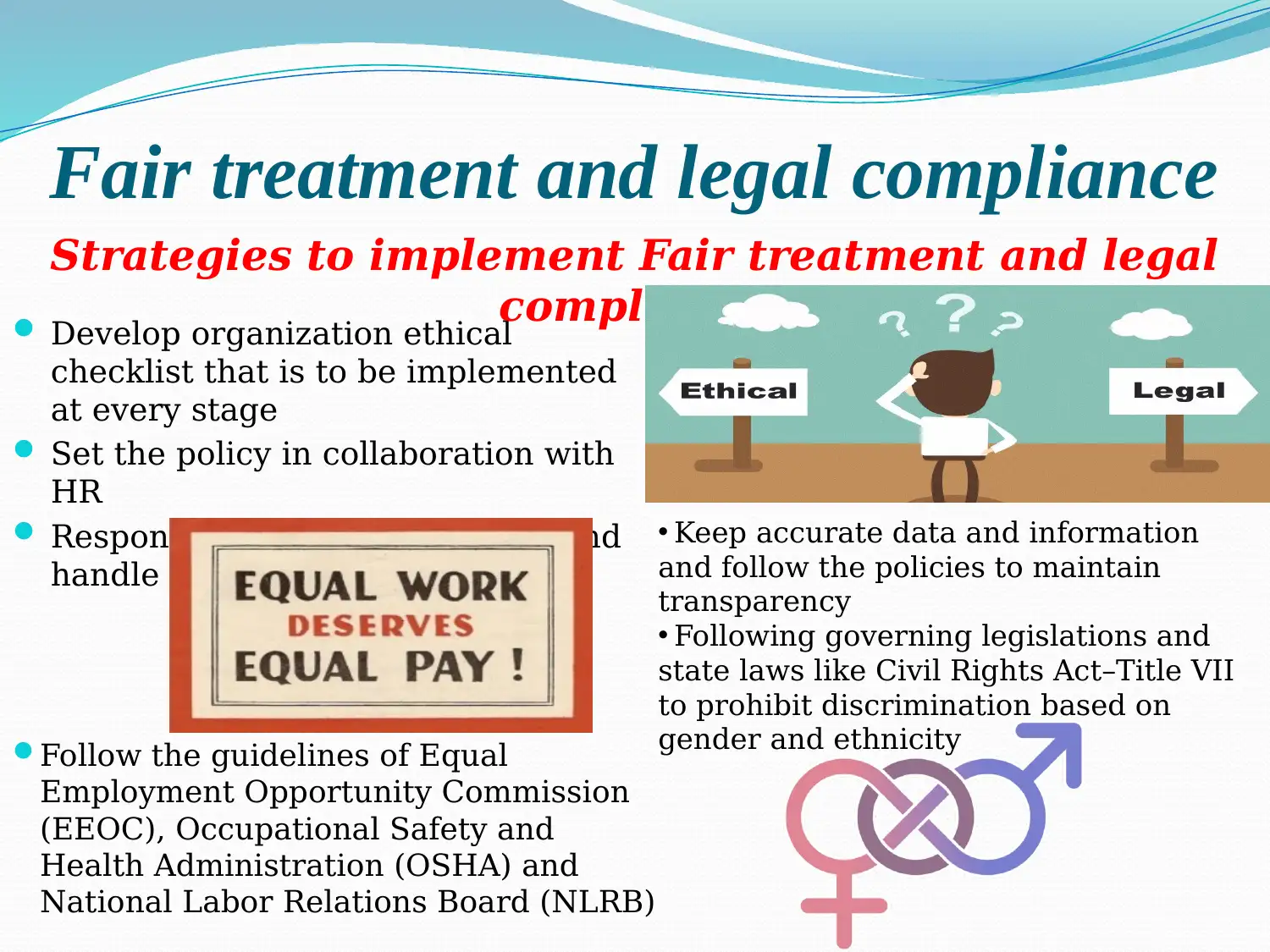
Fair treatment and legal compliance
Follow the guidelines of Equal
Employment Opportunity Commission
(EEOC), Occupational Safety and
Health Administration (OSHA) and
National Labor Relations Board (NLRB)
Develop organization ethical
checklist that is to be implemented
at every stage
Set the policy in collaboration with
HR
Respond to employee concerns and
handle disputes
• Keep accurate data and information
and follow the policies to maintain
transparency
• Following governing legislations and
state laws like Civil Rights Act–Title VII
to prohibit discrimination based on
gender and ethnicity
Strategies to implement Fair treatment and legal
compliance
Follow the guidelines of Equal
Employment Opportunity Commission
(EEOC), Occupational Safety and
Health Administration (OSHA) and
National Labor Relations Board (NLRB)
Develop organization ethical
checklist that is to be implemented
at every stage
Set the policy in collaboration with
HR
Respond to employee concerns and
handle disputes
• Keep accurate data and information
and follow the policies to maintain
transparency
• Following governing legislations and
state laws like Civil Rights Act–Title VII
to prohibit discrimination based on
gender and ethnicity
Strategies to implement Fair treatment and legal
compliance
Secure Best Marks with AI Grader
Need help grading? Try our AI Grader for instant feedback on your assignments.
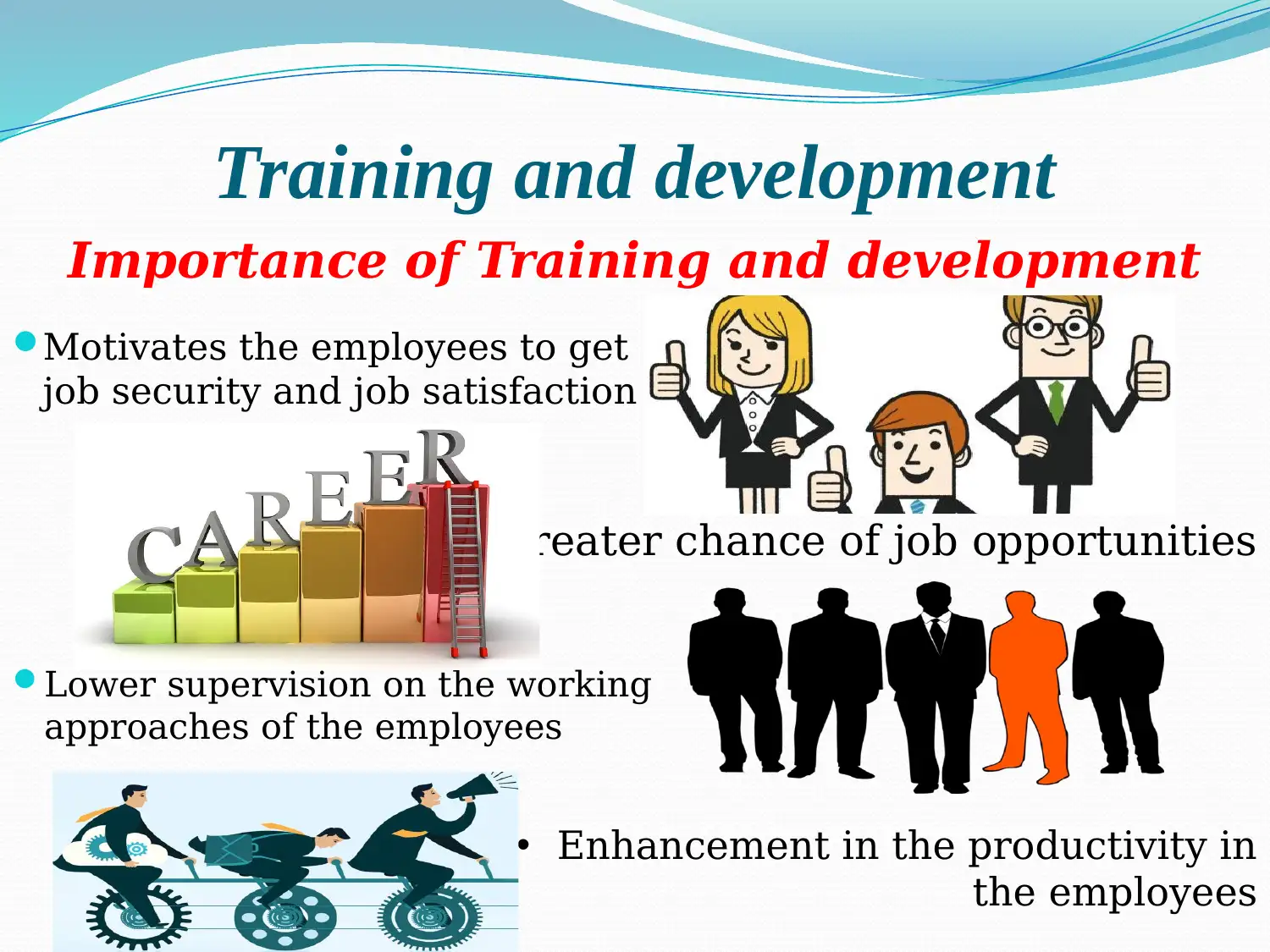
Training and development
Lower supervision on the working
approaches of the employees
Motivates the employees to get
job security and job satisfaction
• Greater chance of job opportunities
Importance of Training and development
• Enhancement in the productivity in
the employees
Lower supervision on the working
approaches of the employees
Motivates the employees to get
job security and job satisfaction
• Greater chance of job opportunities
Importance of Training and development
• Enhancement in the productivity in
the employees
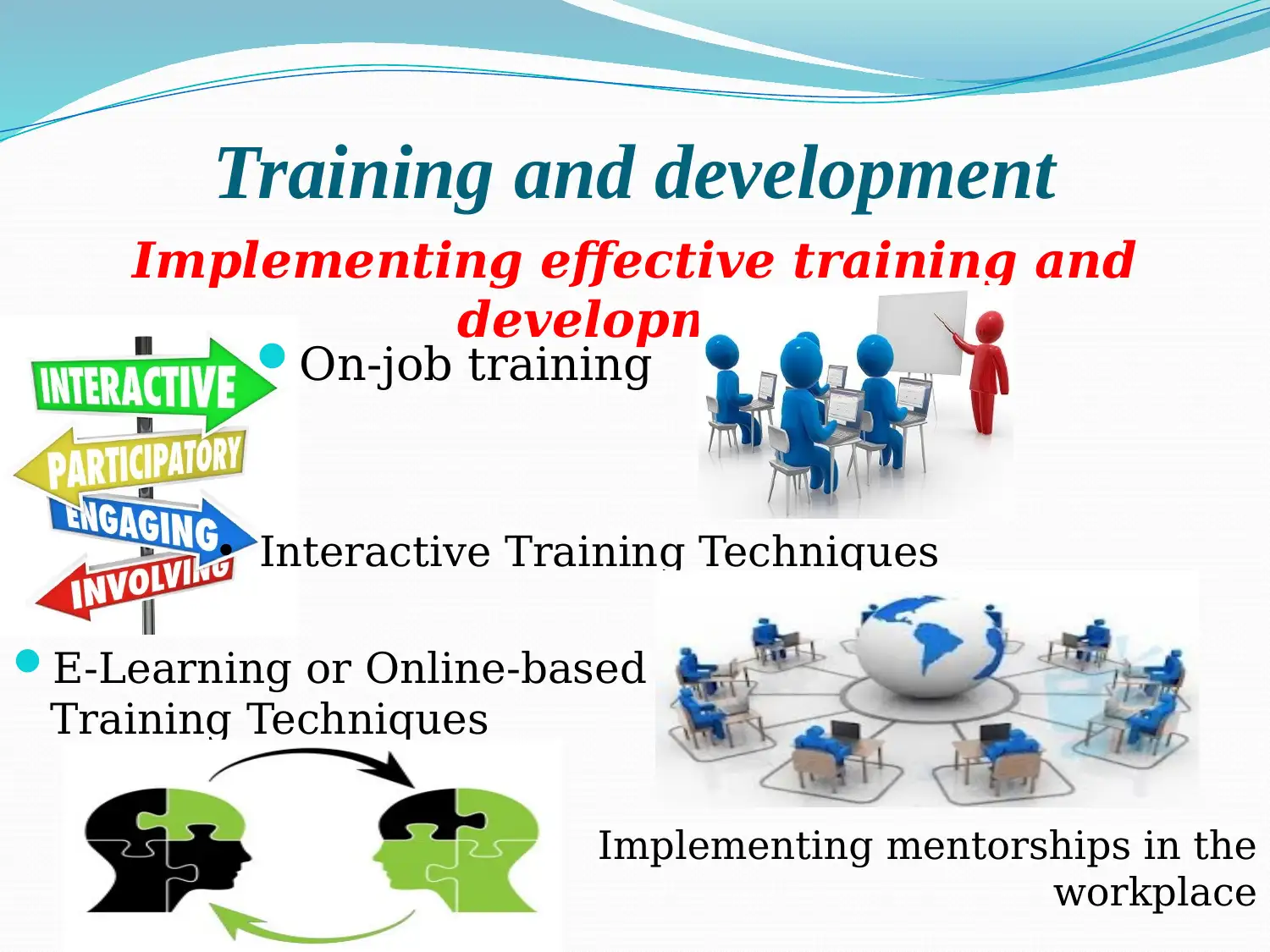
Training and development
E-Learning or Online-based
Training Techniques
On-job training
• Interactive Training Techniques
Implementing effective training and
development
• Implementing mentorships in the
workplace
E-Learning or Online-based
Training Techniques
On-job training
• Interactive Training Techniques
Implementing effective training and
development
• Implementing mentorships in the
workplace
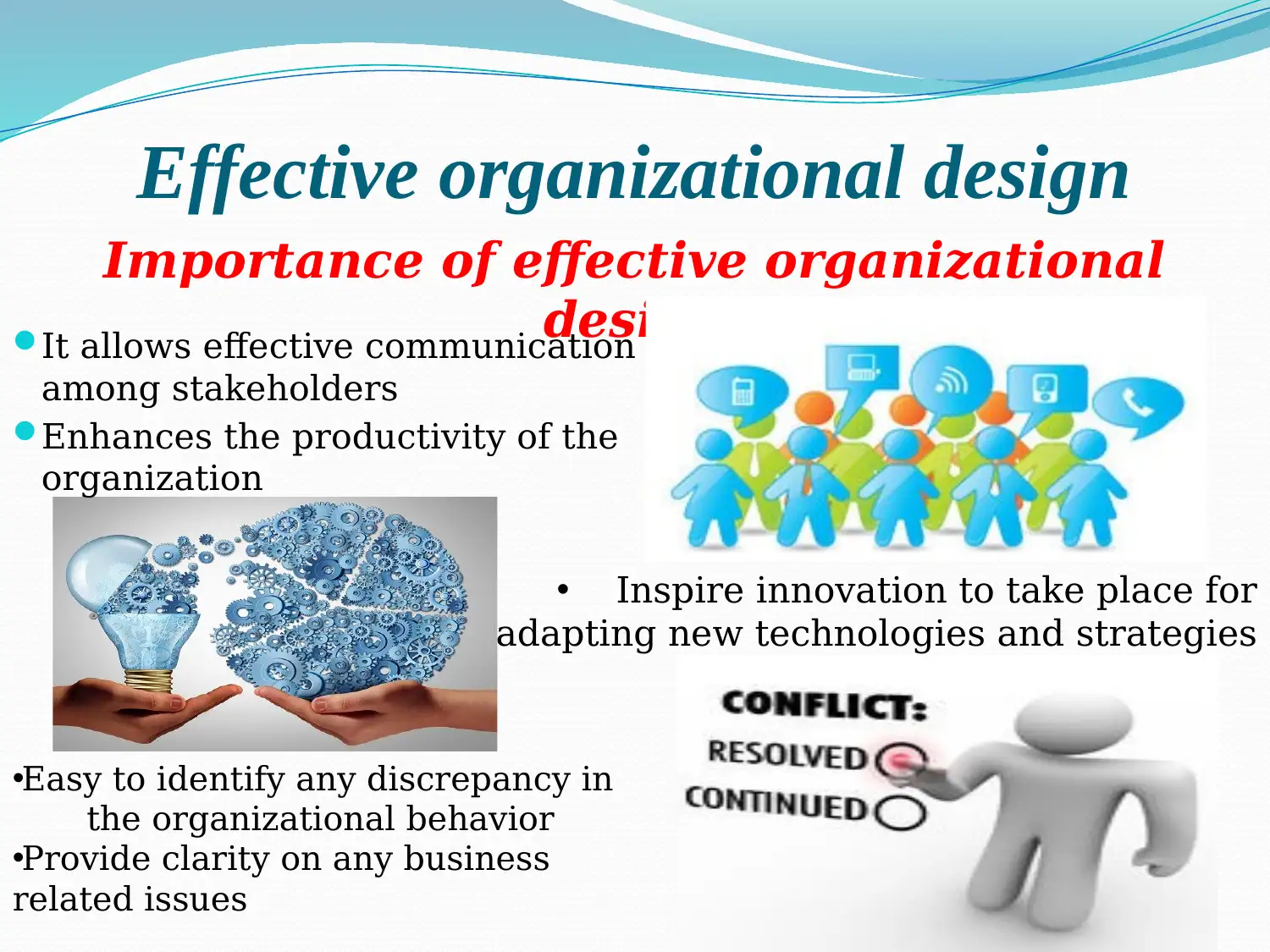
Effective organizational design
•Easy to identify any discrepancy in
the organizational behavior
•Provide clarity on any business
related issues
It allows effective communication
among stakeholders
Enhances the productivity of the
organization
• Inspire innovation to take place for
adapting new technologies and strategies
Importance of effective organizational
design
•Easy to identify any discrepancy in
the organizational behavior
•Provide clarity on any business
related issues
It allows effective communication
among stakeholders
Enhances the productivity of the
organization
• Inspire innovation to take place for
adapting new technologies and strategies
Importance of effective organizational
design
Paraphrase This Document
Need a fresh take? Get an instant paraphrase of this document with our AI Paraphraser
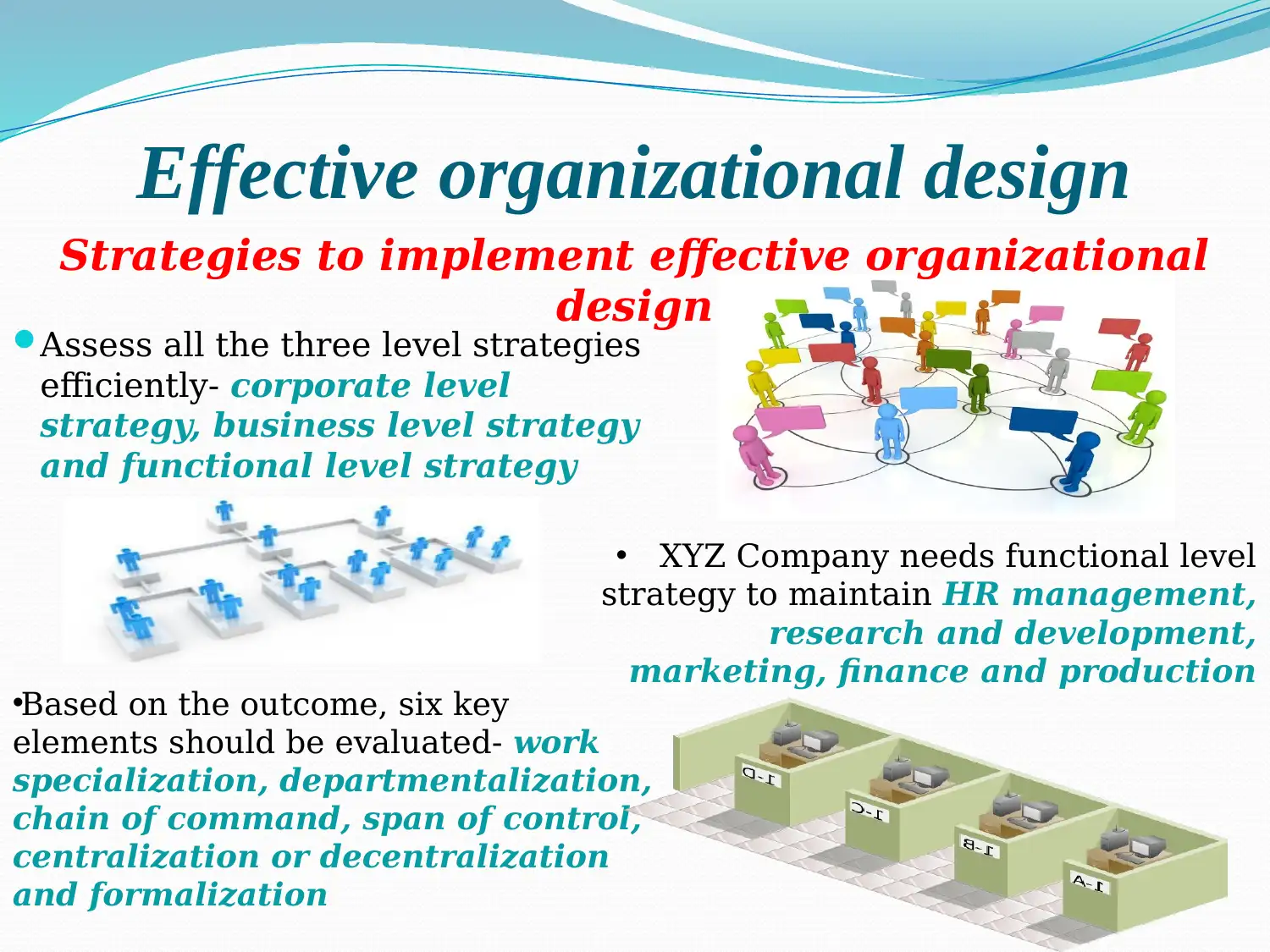
Effective organizational design
•Based on the outcome, six key
elements should be evaluated- work
specialization, departmentalization,
chain of command, span of control,
centralization or decentralization
and formalization
Assess all the three level strategies
efficiently- corporate level
strategy, business level strategy
and functional level strategy
• XYZ Company needs functional level
strategy to maintain HR management,
research and development,
marketing, finance and production
Strategies to implement effective organizational
design
•Based on the outcome, six key
elements should be evaluated- work
specialization, departmentalization,
chain of command, span of control,
centralization or decentralization
and formalization
Assess all the three level strategies
efficiently- corporate level
strategy, business level strategy
and functional level strategy
• XYZ Company needs functional level
strategy to maintain HR management,
research and development,
marketing, finance and production
Strategies to implement effective organizational
design
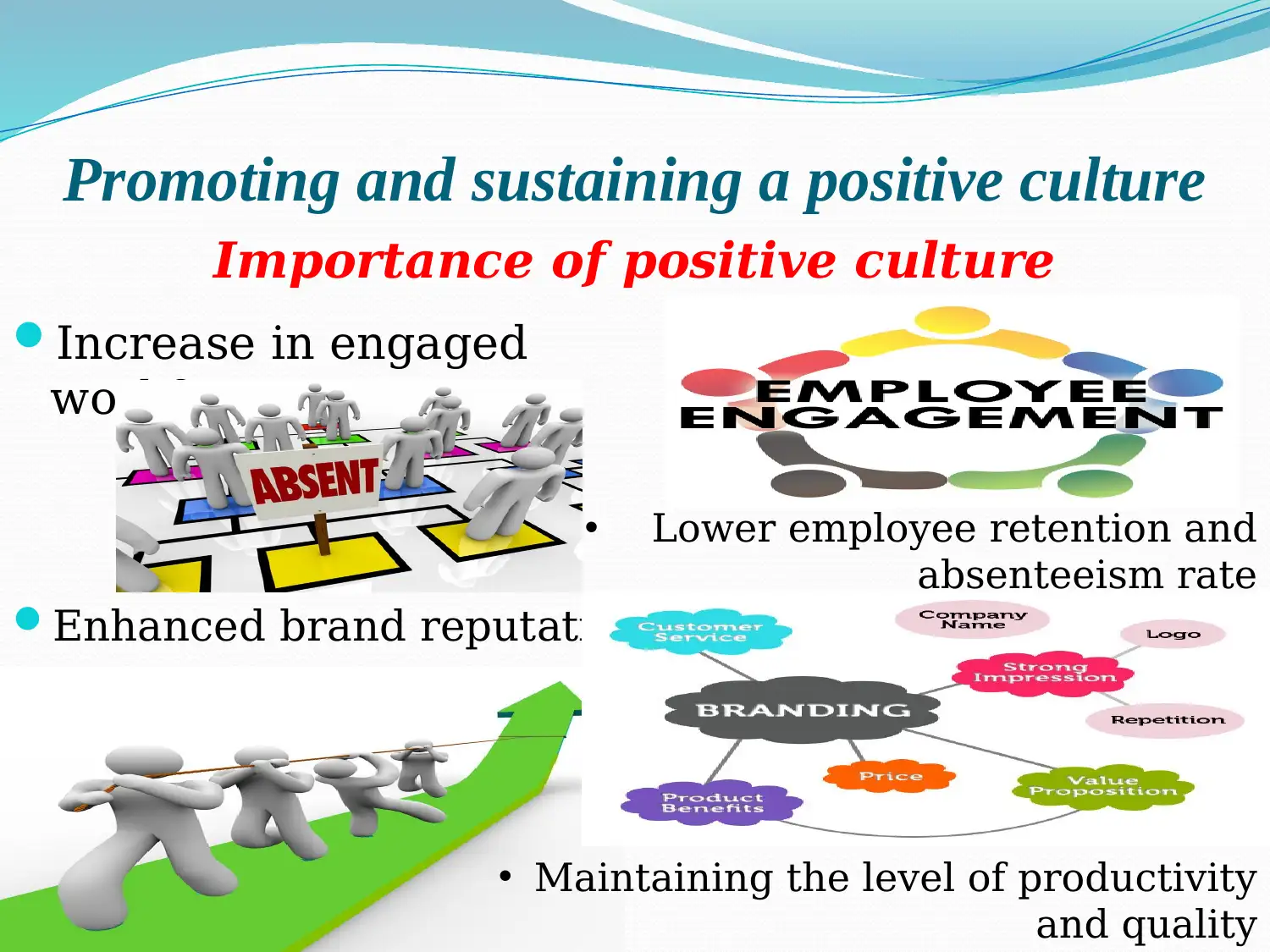
Promoting and sustaining a positive culture
Enhanced brand reputation
Increase in engaged
workforce
Importance of positive culture
• Maintaining the level of productivity
and quality
• Lower employee retention and
absenteeism rate
Enhanced brand reputation
Increase in engaged
workforce
Importance of positive culture
• Maintaining the level of productivity
and quality
• Lower employee retention and
absenteeism rate
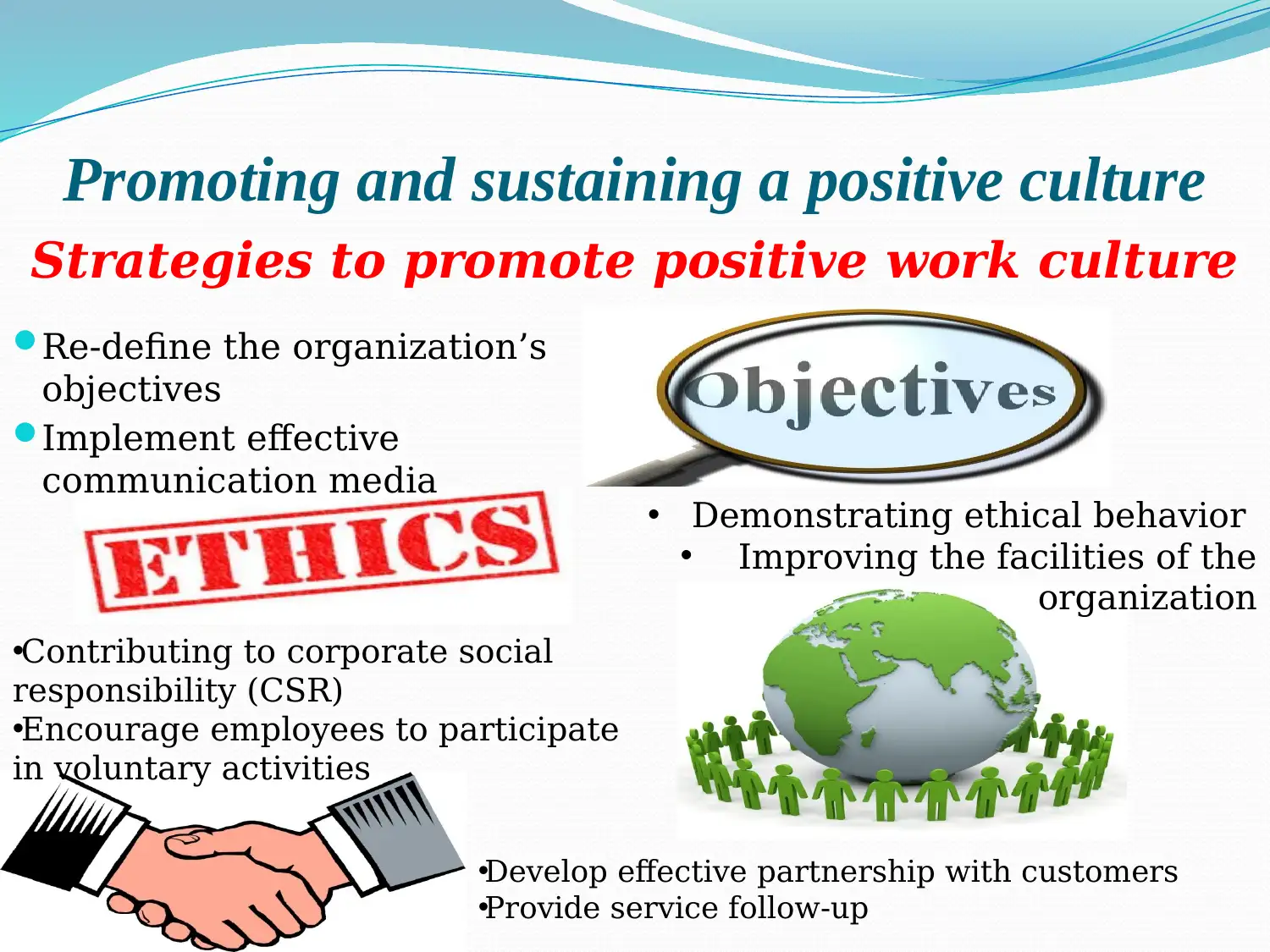
Promoting and sustaining a positive culture
•Contributing to corporate social
responsibility (CSR)
•Encourage employees to participate
in voluntary activities
Re-define the organization’s
objectives
Implement effective
communication media
Strategies to promote positive work culture
•Develop effective partnership with customers
•Provide service follow-up
• Demonstrating ethical behavior
• Improving the facilities of the
organization
•Contributing to corporate social
responsibility (CSR)
•Encourage employees to participate
in voluntary activities
Re-define the organization’s
objectives
Implement effective
communication media
Strategies to promote positive work culture
•Develop effective partnership with customers
•Provide service follow-up
• Demonstrating ethical behavior
• Improving the facilities of the
organization
Secure Best Marks with AI Grader
Need help grading? Try our AI Grader for instant feedback on your assignments.
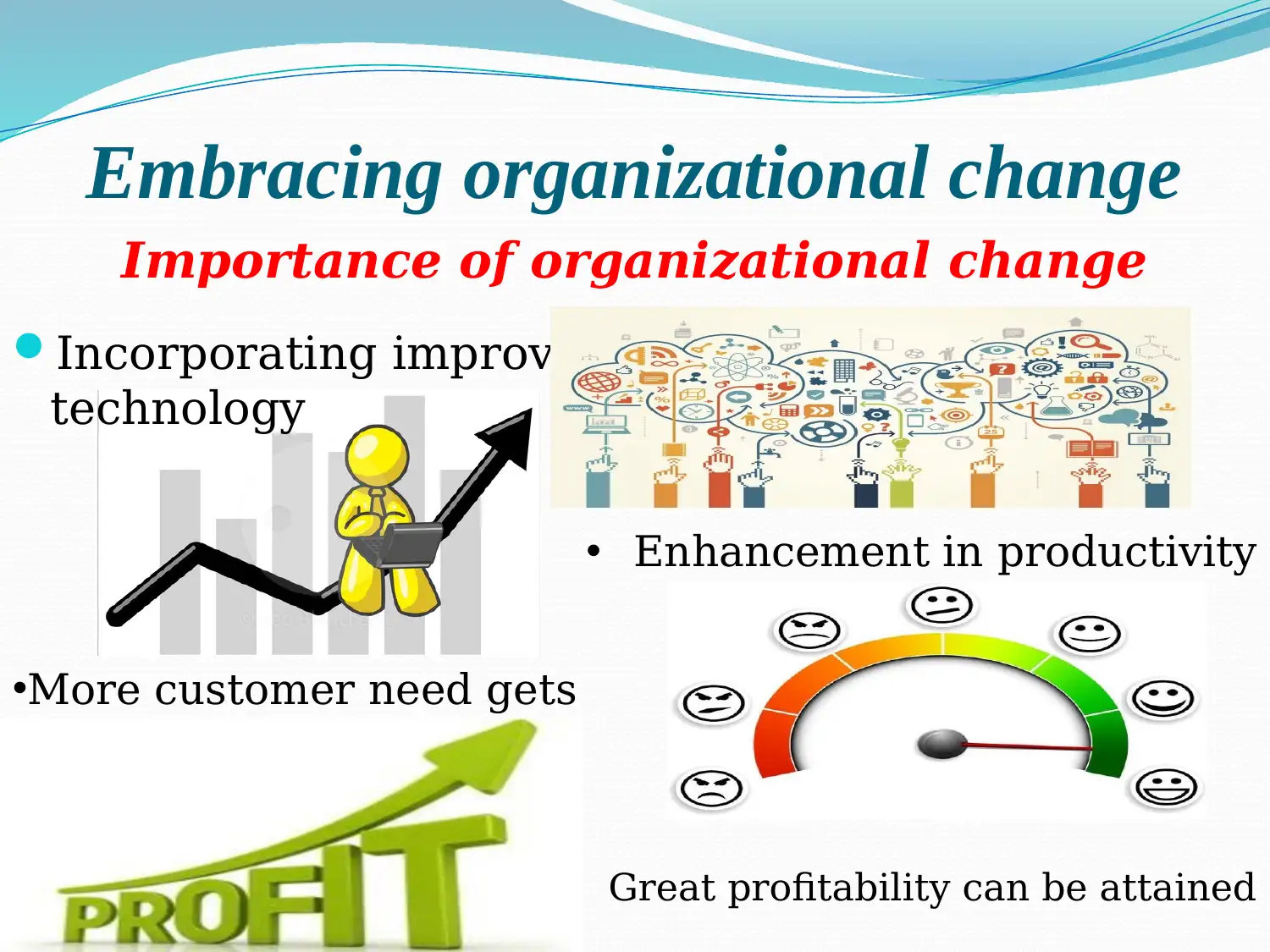
Embracing organizational change
•More customer need gets
fulfilled
Incorporating improved
technology
• Enhancement in productivity
Importance of organizational change
• Great profitability can be attained
•More customer need gets
fulfilled
Incorporating improved
technology
• Enhancement in productivity
Importance of organizational change
• Great profitability can be attained
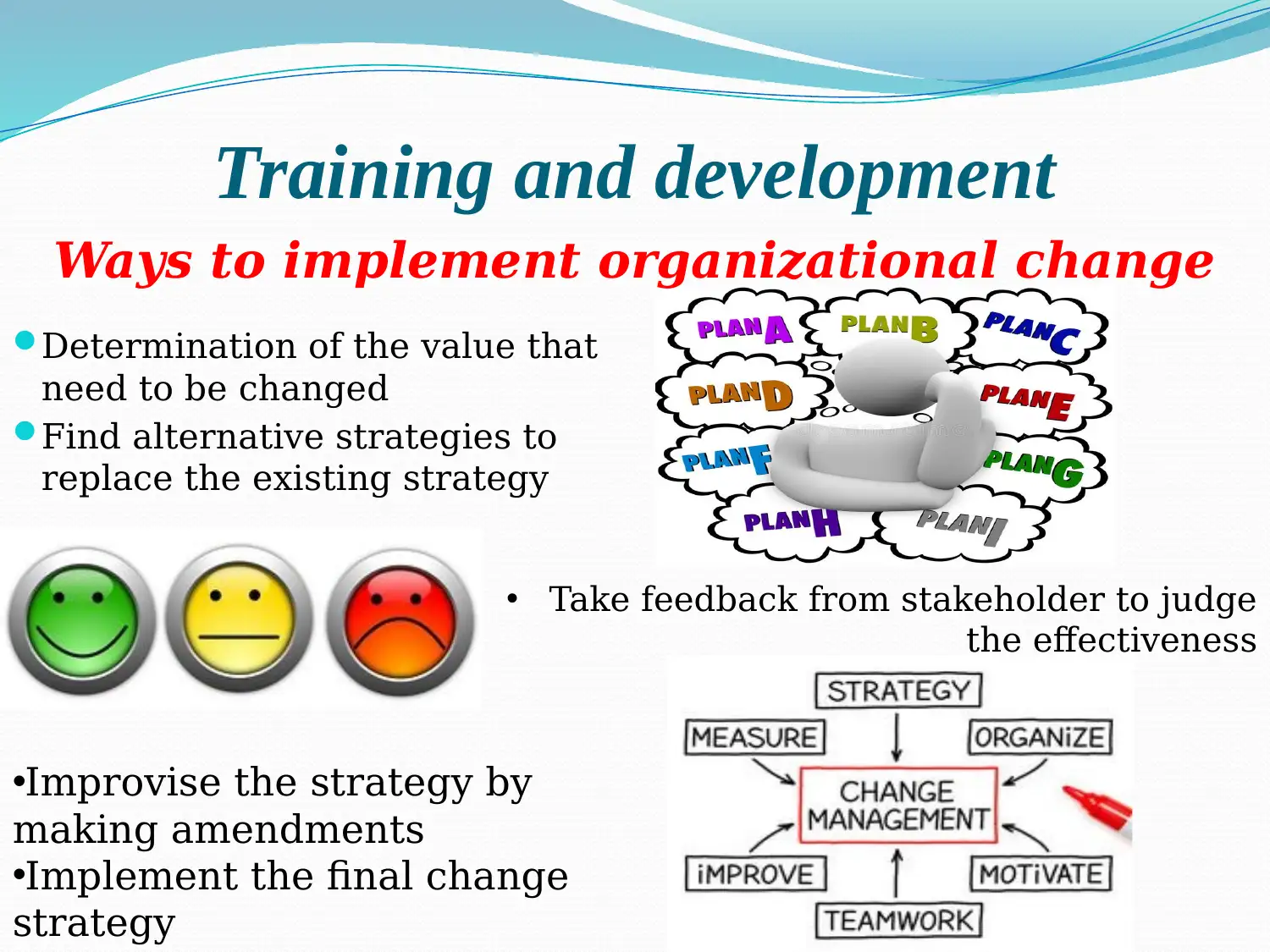
Training and development
•Improvise the strategy by
making amendments
•Implement the final change
strategy
Determination of the value that
need to be changed
Find alternative strategies to
replace the existing strategy
• Take feedback from stakeholder to judge
the effectiveness
Ways to implement organizational change
•Improvise the strategy by
making amendments
•Implement the final change
strategy
Determination of the value that
need to be changed
Find alternative strategies to
replace the existing strategy
• Take feedback from stakeholder to judge
the effectiveness
Ways to implement organizational change
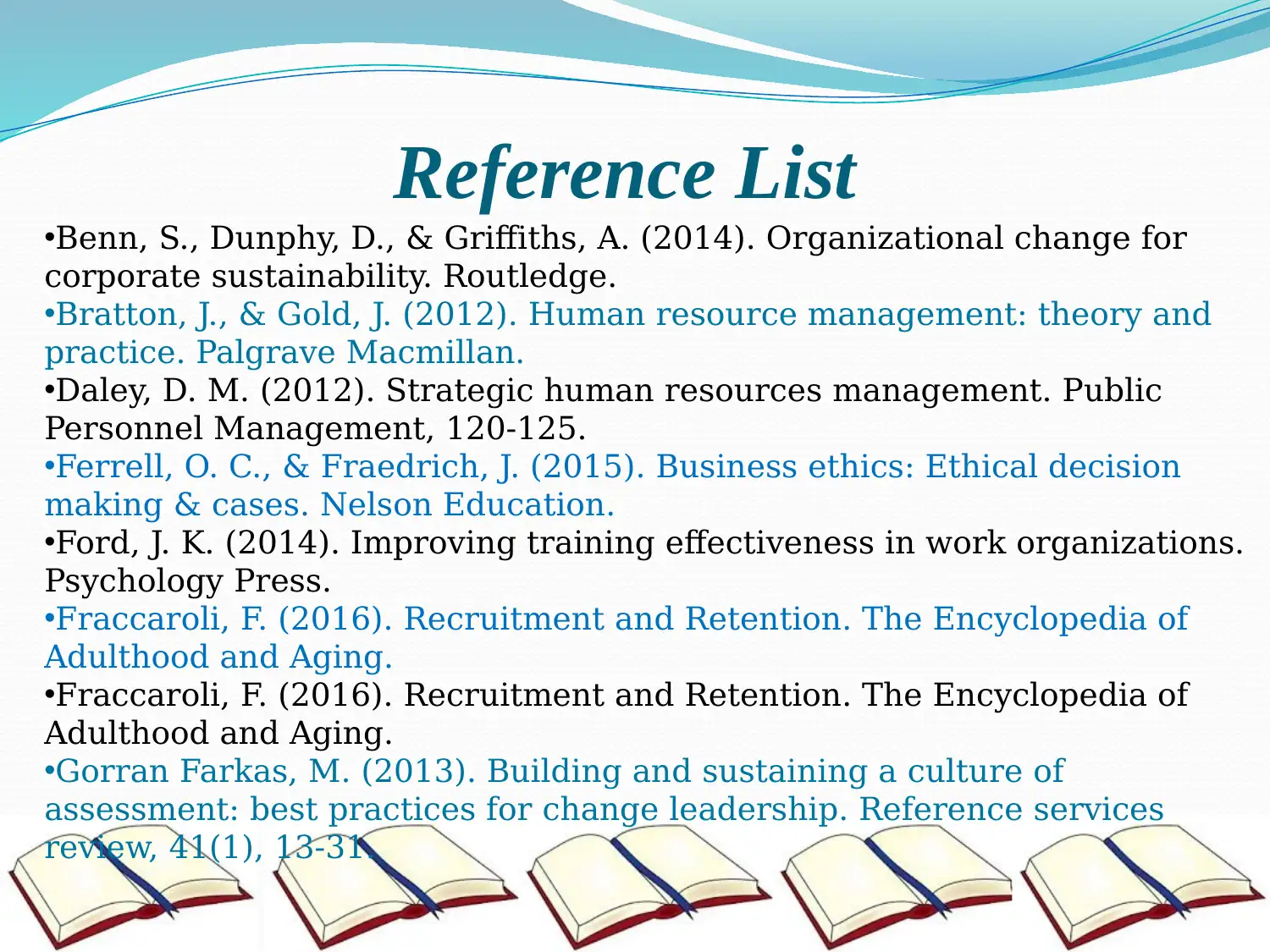
Reference List
•Benn, S., Dunphy, D., & Griffiths, A. (2014). Organizational change for
corporate sustainability. Routledge.
•Bratton, J., & Gold, J. (2012). Human resource management: theory and
practice. Palgrave Macmillan.
•Daley, D. M. (2012). Strategic human resources management. Public
Personnel Management, 120-125.
•Ferrell, O. C., & Fraedrich, J. (2015). Business ethics: Ethical decision
making & cases. Nelson Education.
•Ford, J. K. (2014). Improving training effectiveness in work organizations.
Psychology Press.
•Fraccaroli, F. (2016). Recruitment and Retention. The Encyclopedia of
Adulthood and Aging.
•Fraccaroli, F. (2016). Recruitment and Retention. The Encyclopedia of
Adulthood and Aging.
•Gorran Farkas, M. (2013). Building and sustaining a culture of
assessment: best practices for change leadership. Reference services
review, 41(1), 13-31.
•Benn, S., Dunphy, D., & Griffiths, A. (2014). Organizational change for
corporate sustainability. Routledge.
•Bratton, J., & Gold, J. (2012). Human resource management: theory and
practice. Palgrave Macmillan.
•Daley, D. M. (2012). Strategic human resources management. Public
Personnel Management, 120-125.
•Ferrell, O. C., & Fraedrich, J. (2015). Business ethics: Ethical decision
making & cases. Nelson Education.
•Ford, J. K. (2014). Improving training effectiveness in work organizations.
Psychology Press.
•Fraccaroli, F. (2016). Recruitment and Retention. The Encyclopedia of
Adulthood and Aging.
•Fraccaroli, F. (2016). Recruitment and Retention. The Encyclopedia of
Adulthood and Aging.
•Gorran Farkas, M. (2013). Building and sustaining a culture of
assessment: best practices for change leadership. Reference services
review, 41(1), 13-31.
Paraphrase This Document
Need a fresh take? Get an instant paraphrase of this document with our AI Paraphraser
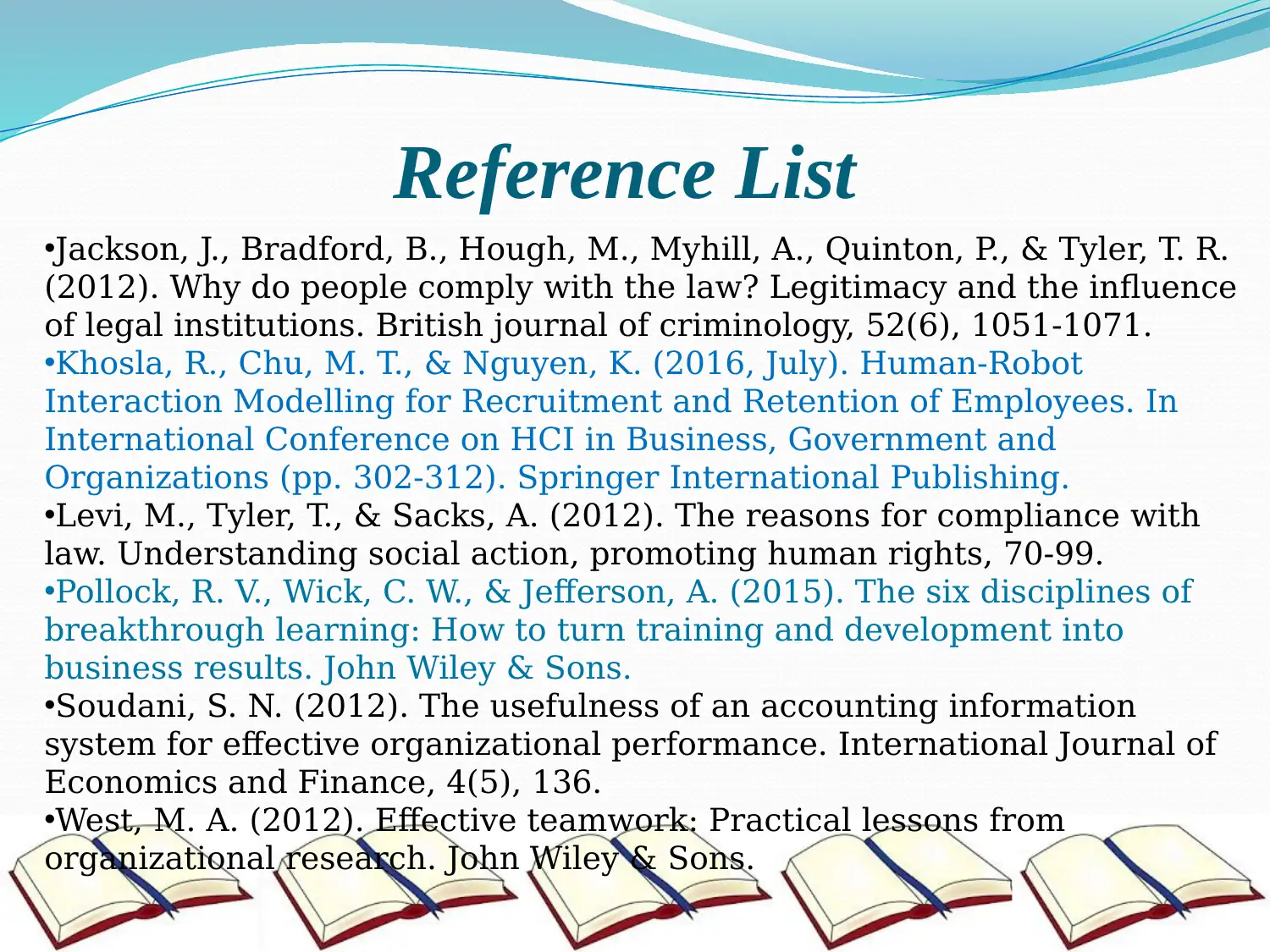
Reference List
•Jackson, J., Bradford, B., Hough, M., Myhill, A., Quinton, P., & Tyler, T. R.
(2012). Why do people comply with the law? Legitimacy and the influence
of legal institutions. British journal of criminology, 52(6), 1051-1071.
•Khosla, R., Chu, M. T., & Nguyen, K. (2016, July). Human-Robot
Interaction Modelling for Recruitment and Retention of Employees. In
International Conference on HCI in Business, Government and
Organizations (pp. 302-312). Springer International Publishing.
•Levi, M., Tyler, T., & Sacks, A. (2012). The reasons for compliance with
law. Understanding social action, promoting human rights, 70-99.
•Pollock, R. V., Wick, C. W., & Jefferson, A. (2015). The six disciplines of
breakthrough learning: How to turn training and development into
business results. John Wiley & Sons.
•Soudani, S. N. (2012). The usefulness of an accounting information
system for effective organizational performance. International Journal of
Economics and Finance, 4(5), 136.
•West, M. A. (2012). Effective teamwork: Practical lessons from
organizational research. John Wiley & Sons.
•Jackson, J., Bradford, B., Hough, M., Myhill, A., Quinton, P., & Tyler, T. R.
(2012). Why do people comply with the law? Legitimacy and the influence
of legal institutions. British journal of criminology, 52(6), 1051-1071.
•Khosla, R., Chu, M. T., & Nguyen, K. (2016, July). Human-Robot
Interaction Modelling for Recruitment and Retention of Employees. In
International Conference on HCI in Business, Government and
Organizations (pp. 302-312). Springer International Publishing.
•Levi, M., Tyler, T., & Sacks, A. (2012). The reasons for compliance with
law. Understanding social action, promoting human rights, 70-99.
•Pollock, R. V., Wick, C. W., & Jefferson, A. (2015). The six disciplines of
breakthrough learning: How to turn training and development into
business results. John Wiley & Sons.
•Soudani, S. N. (2012). The usefulness of an accounting information
system for effective organizational performance. International Journal of
Economics and Finance, 4(5), 136.
•West, M. A. (2012). Effective teamwork: Practical lessons from
organizational research. John Wiley & Sons.
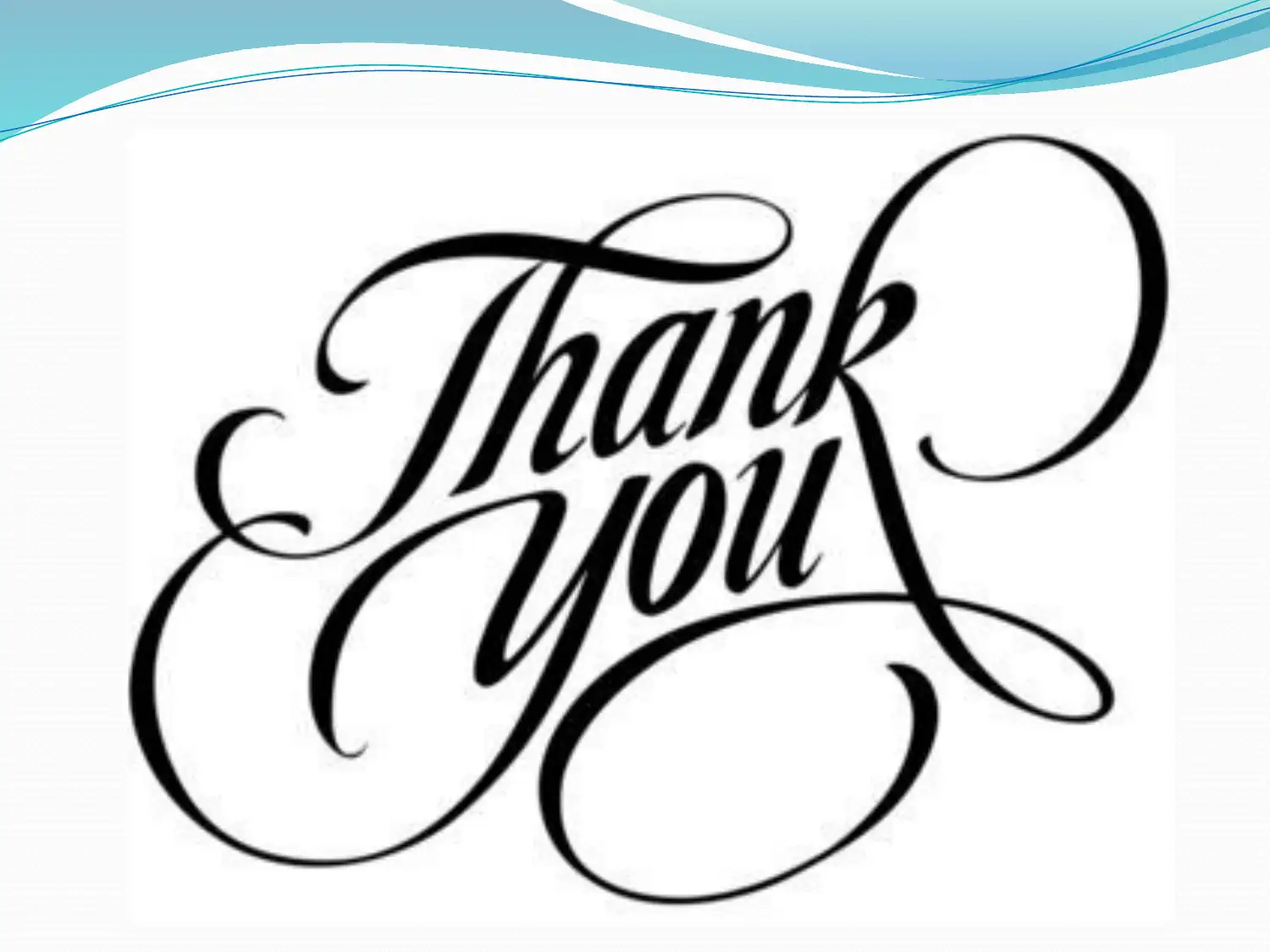
1 out of 21
Related Documents
Your All-in-One AI-Powered Toolkit for Academic Success.
+13062052269
info@desklib.com
Available 24*7 on WhatsApp / Email
![[object Object]](/_next/static/media/star-bottom.7253800d.svg)
Unlock your academic potential
© 2024 | Zucol Services PVT LTD | All rights reserved.




